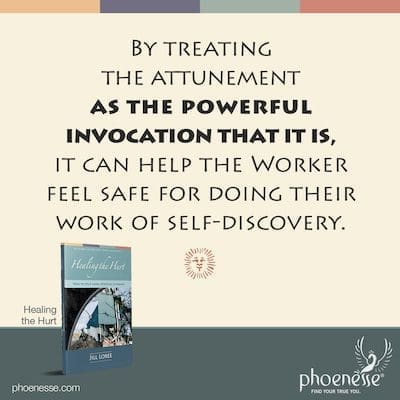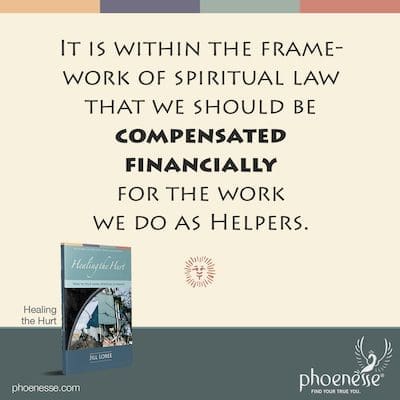- A Word about Attuning
- Money and Spiritual Work
- Knowing When to Refer Out
- Helper Agreement
- Please Say This Isn’t the End
A Word about Attuning
An attunement is an opportunity for the Helper and the Worker to get on the same wavelength. It is typically done by closing our eyes and holding hands. If we point our thumbs left, the energy can flow in a smooth circuit around our bodies.
This thumbs-left device may be more helpful when people hold hands in a group to attune. For two people, it can be enough to just hold hands, however they come together. For non-local sessions over the phone or computer, both people can close their eyes and figuratively hold hands, knowing the attunement is still happening on an unseen level.
This is a good time to say a prayer, or invocation, and invite in the Higher Self energies. One could argue that the Higher Self is always present, and this would be true. Nonetheless, it is important to give our attention to “calling in” the Higher Self. For the Higher Self is an integral part of the container that holds our work of exposing and healing the Lower Self.
This can also be a good time for the Worker to state an intention for their session. We may want to start by first saying a prayer and intention ourselves. Then invite the Worker to do the same. This brings their voice into the room. More importantly, it adds their energy and consciousness to the formation of the container we build together to hold the work of healing.

The attunement can be a place to allow our creativity to continually bring in new ways of connecting. Or we may find a comfortable routine that brings a nice and familiar opening to our sessions. This is a matter of personal preference for a Helper. For new Helpers especially, we may feel that we need to have something prepared to say.
The attunement is also a good opportunity to open and drop into Helper Consciousness. We can allow whatever words or thoughts to come through that we feel inspired to speak. Over time, we will learn to trust this guidance. For even when these words seem rather vanilla, it is amazing to see how they often become like a thread that keeps re-appearing throughout the session. Let this weaving strengthen the walls of the container.
The attunement can also be a time to read a few words from the Guide. This brings in the Guide’s energy, which is conveyed through the words in the lectures. Or we may feel inspired to call in one or more qualities—peace, unity, kindness, etc.—or spiritual beings—Christ, the Guide, Kwan Yin, etc.—to be present in the session. Again, invite the Worker to do the same.
In some spiritual communities, this can serve as an opening ritual that creates a cohesive container for an entire group. An attunement ends with the pulse of a hand squeeze by the Helper. In a group, this pulse is sent around the circle from person to person.
We may want to try out different ideas to find our own groove with what feels most comfortable during attunement. By treating the attunement as the powerful invocation that it is, it sets a sacred space for the session. It also imparts a sense of warmth and intimacy for the Worker that can go a long way in helping them feel safe for doing their work of self-discovery.
Money and Spiritual Work
Eva began her task of speaking the Guide’s teachings in the late 1950s. She could not have guessed that this would continue monthly for 22 years and result in the remarkable body of material we have today, known as the Pathwork Guide lectures.
Following her death in 1979, it was not a direct path to having the lectures available online for free, in both print and audio formats. But fortunately, this is what the Pathwork Foundation is now offering. It’s not uncommon that a person seeking out a Helper today may have been reading the material online for some time. And now feel ready to dive into doing the work.
But while the teachings are offered for free, our time and experience as a Helper are not. Eva herself gave her time for free for some time, in service to bringing the Guide’s teachings forward into the world. At some point, the Guide encouraged her to begin charging people money to have sessions with her. Similarly, as we develop in our early Helpership, we must go through various stages until we get a green light to move to the next stage.

It should not be overlooked that before we even get to the starting gate of becoming a Helper, there will be several years required of formal participation in a Helpership Training program. In my own experience, having enrolled in the four-year training program offered by the Pathwork of Georgia in the mid-2000s, I invested over $8000 per year in my training. This included the cost for instruction, travel (several weekend-long classes each year were held in another city), bi-weekly Helper sessions, and an annual workshop led by a Senior Pathwork Helper.
Following this was a period of three years comprised of apprenticing in a Pathwork group (essentially an unpaid assistant). Then came a time of continued personal work to reach my own personal state of readiness to claim my Helpership. This claiming of Helpership requires a deep level of commitment and discernment. We do this following the guidance of a Pathwork teacher or, in some cases, a hand-selected group of Helpers.
All of this to say, by the time we reach the gates of becoming a full Helper, we have invested heavily in our training. This, of course, is above and beyond all the years of paying fees to participate in groups, individual sessions and workshops as a Worker prior to this. Any notion that we should not be compensated for our time and expertise in helping others because this is “spiritual work” is, quite frankly, misguided.
According to the Guide, it is within the framework of spiritual law that we should be compensated financially for the work we do as Helpers. But there are some aspects of these laws that are important for us to realize. First, we must start out offering our help for free or for very little compensation. For me this meant starting out by doing free practice sessions (with the instructor present) during our training classes. This was followed by working with a nonpaying Worker. I then transcribed the recordings of those sessions for review and feedback during paid supervision sessions.
From here, once we receive the green light—which is an internal sense, but which also follows a general timeframe of six or more months—we can begin charging a minimal amount for sessions, perhaps something like $40-50 per hour. As we develop confidence in ourselves as Helpers, we gradually charge more. Eventually, we are charging a rate commensurate with the going rate in our geographic area for spiritual healers, corresponding with our level of experience. In 2016, this ranges anywhere from $85/hour up to $140/hour for a highly seasoned Helper in a region of the US with a high cost of living.
While every Helper must find their own level of comfort with the rate they charge, there are a few things to consider. We may be willing to offer a reduced rate to a Worker who is unable to pay our full rate. But we need to make sure we never charge an amount that we will later resent the Worker for. We may also want to make finances a topic for work in our sessions. Since for this Worker, money likely presents some type of challenge.
Note, Eva was known to conduct budget sessions with her Workers. She would go through their finances with them, in detail, to help uncover the root cause of whatever problems the Worker had with money.
It is equally important that we avoid the feeling dependent on our Workers for our income. If we are a full-time Helper, this may indeed be the case. But we need to be mindful about creating a forcing current that pushes for a certain number of sessions. Or creates an emotional reaction in us if our Worker cancels an appointment or stops having sessions.
That said, our time is valuable. We need to ask our Workers to follow standard conventions around missed appointments. This includes providing adequate notice if they must change or miss an appointment. And paying for the session even if they don’t come. This dovetails with the path’s call to self-responsibility.
This is standard operating protocol for almost any type of appointment-based service today. Helper sessions, though, often have an added kick of resistance coming from the Lower Self. Certainly, everyone has conflicts from time-to-time regarding the scheduling of their sessions. But as Helpers, we need to be on the lookout for Lower Self tricks that sabotage or undermine the work. Our Workers are counting on us to not collude with their Lower Self.
Interestingly, over the course of my own training, I came to rely heavily on what I refer to as my “scheduling angels.” Having made a deep commitment to this work, I found that my schedule was miraculously guided to accommodate all that was required.
This was significant, considering my days were also completely filled with the regular activities involved in raising two young children. Plus, I had a career that at the time involving significant international travel. Admittedly, I was often exhausted. But I managed to fit it all in. When I had a genuine conflict, I learned to let it go and trust that all was well. In the end, it always was.
Lastly, it is not uncommon for Helpers to offer a sliding scale. This means they charge less for sessions with someone who is not able to pay their normal rate. However, it is necessary to have adequate ego strength to do this work of self-purification. So we may want to consider whether such a person is really ready.
Sometimes, a person’s ego is not yet disciplined enough for them to provide for themselves financially, As such, they cannot also pay for the healing work they claim they desire. In such a case, the person may lack the fortitude needed for the difficult task of dealing directly with their own Lower Self. There are no clear-cut answers on this, but certainly some valid points to consider.
Knowing When to Refer Out
Becoming a Helper is a spiritual calling. There is guidance supporting us and our teachers, and we can feel how this work is bathed in blessings from the divine. But by no means does this mean there won’t be problems, on many levels.
For starters, for various reasons, we can’t help everyone. In some cases, it may be the Worker who leaves. As the Guide tells us, many will be called, but few will stay. Of course, that was 50 years ago, and certainly far more people are ready to do deep spiritual work today than there were back then. Nonetheless, more people will be introduced to this path and these spiritual teachings than will stick. This is their choice and we are not advised to run after those who choose to walk away.
That said, the Guide also tells us that no one comes to these teachings by casual circumstances. The Spirit World puts considerable effort into every introduction. Then it’s up to the person to follow through. We may want to take steps to align with a potential Worker’s Higher Self and encourage them to not give up too quickly what has been painstakingly brought to their doorstep.
For those who do stay and who wish to work with us as their Helper, we will want to consider some type of in-take process. This gives us a chance to assess the person’s readiness. It includes evaluating the individual for maladies such as depression, serious behavioral problems and active addictions. If someone is currently involved in treatment for something of this nature, we need to consider whether we feel they are ready to do this work. If they are, are they a good match for working with us?

It is possible we will have some concerns to bring forward candidly with the Worker. Then we will want to monitor our work together for signs that this person would be better served by seeking traditional therapy or counseling. If that is the case, we may want to offer them suggestions for local resources. But there are no hard and fast rules.
It is also possible that concurrent therapy to deal with a specific issue can support the work they do with us. In general, however, the Guide cautions that a person should not simultaneously work with more than one Helper. Because this easily leads to splitting—sharing some things with one Helper and other things with another.
In doing this, the Worker circumvents the humility and vulnerability that is an inherent part of doing the work of healing. When having more than one healer, Helper or therapist is unavoidable, we may want to ask the Worker for permission to be in contact with their other healers periodically about their work.
In the area of prescription drugs, clearly a Worker must be under the care of an appropriate licensed professional. We have no input or comment on this aspect of their personal health. It is possible that such medications give a person the stable ground they need to be able to face the deeper distortions affecting them. But we must always maintain clear boundaries about our work. We must not venture into territory for which we have not been trained and are not qualified to offer advice or support.
Of course, many people who feel called to become Helpers are already trained in other healing modalities. This training may give them further options for how to work with and support their patients or clients who may also be their Workers.
When a person goes to a healer, of whatever variety, they are entering into a contract of sorts with that healer for a specific type of care or healing. We need to honor this nonverbal contract. We can even take steps to clarify in writing the exact nature of the Helper/Worker contract we are entering into together. If we are trained in other modalities, we may want to weave them together in how we offer our Helpership. However we proceed, we need to be clear about this with our Workers and clean about our boundaries.
Here is proposed language to use in constructing a contract with a Worker:
Helper Agreement
From Pathwork lecture #204, What is the Path:
“This Pathwork is not psychotherapy, although aspects of it must necessarily deal with areas psychotherapy also deals with. In the framework of the Pathwork, the psychological approach is only a side issue, a way of getting through obstructions.
It is essential to deal with confusions, inner misconceptions, misunderstandings, destructive attitudes, alienating defenses, negative emotions, and paralyzed feelings, all of which psychotherapy also attempts to do and even posits as its ultimate goal.
In contrast, the Pathwork enters its most important phase only after this first stage is over. The second and most important phase consists of learning how to activate the greater consciousness dwelling within every human soul.”
As a Pathwork Helper, my goal is to help you activate the divinity that dwells in your soul. We will do this by drawing from the teachings in the Pathwork lectures. Our work together—whether in individual sessions, groups or classes—may include various spiritual practices including movement, meditation and journaling.
I am not a psychotherapist. I may advise a Worker with serious psychological problems (such as psychosis, severe depression, suicidal ideation or severe anxiety) to seek a licensed therapist. It is the Worker’s responsibility to find the appropriate care.
I am not a medical doctor. Nothing I say or suggest should be construed as medical advice. It is the Worker’s responsibility to seek and follow the appropriate medical care he or she needs.
Payment should be made at the time of each group or session. Please respect individual session times by giving 24-hour notice to cancel or reschedule whenever possible.
I have read and understand this agreement. Except in the case of gross negligence or malpractice, I or my representative(s) agree to fully release and hold harmless Jill Loree from and against any and all claims or liability of whatsoever kind or nature arising out of or in connection with my session(s).
Name (print):____________________
Signature:______________________
Date:__________________________
It is important to note that this spiritual path is not a program for recovering from addiction. Many who are attracted to this work, however, have experience with recovery by way of a spiritual program such as Alcoholics Anonymous. Those teachings are highly compatible and the Guide’s message can offer the deeper healing that such a person is seeking. But when a potential Worker is clearly still grappling with the throws of addiction or alcoholism, it will most often be necessary to refer them to a program designed to treat such a problem first, before turning to doing this deeper spiritual work.
Other reasons to refer out a potential Worker include countertransference that feels beyond what we can address through our own ongoing work as a Helper. In countertransference, we are triggered into an Emotional Reaction by the Worker. We certainly always need to address this in our ongoing supervision. But no Helper is free from all their inner entanglements. So it is not realistic to believe that countertransference will never surface for us as a Helper. What is expected is that we watch for it and address it as soon as we are aware of it.
Lastly, we need to be aware that sexual attraction with a Worker is something that happens, and we don’t need to run away from it. Unless the attraction is so overwhelming or distracting for us that we do not feel we can help this person, we need to deal with it. We need to be conscious of how we are managing our energy with the Worker. Be mindful about not seducing them or teasing them to possibly prop up our own weak ego.
We must never act out our sexual feelings with a Worker, either within a session or outside of a session. Beyond this, many years would need to have passed after a Helper-Worker relationship ended for it to be possibly appropriate for a personal, intimate relationship to develop. And even then, it’s not advisable.
Please Say This Isn’t the End
It is said that all good things must come to an end. But a good Helper-Worker relationship can endure for decades. As our work remains evergreen, constantly rolling with the changes in our lives, there is ever more ground we can cover. The road of healing is seemingly endless. If we finish all we have planned for this incarnation, new material that was on deck for our next lifetime will rise up. So we never have to fear running out of work to do!

But in the real world, sometimes there is cause for an ending. When, for whatever reason, a Worker decides it is time to move on, we need to let them go. We can do this while also bringing our full attention to the letting go process. Many of us have a history of leavings that have left a lot of frayed edges. Here’s a chance to leave with consciousness and with care.
If the Worker has feedback for us about any lack in us as Helpers, we want to humbly open to hearing this. Know too, that it may be loaded with a boatload of distortion. But it could also contain a grain of truth. More importantly, we want to help the Worker walk through this ending without feeling the need to make us—or something about working with us—bad.
People often do this so they can justify cutting off feelings they don’t want to feel. This time, we can invite the Worker to keep bringing their feelings forward. This can potentially heal other old wounds from rough-and-ragged endings. At the same time, we can support them in taking steps to walk away. This isn’t easy to do and may take more than one session to achieve completion. But we can offer a healing departure for our Worker that is a gift they will carry with them, wherever they go.
For Workers with whom we have a long, ongoing healing relationship, it’s important that we continually let go of our impressions about who this person is. Deep healing work will transform the way a person shows up in the world. While we may have first met them when they were immature and mired in blindness, we want them to grow and evolve. It is important that we don’t hold our Workers to their history.
As the light of the Worker becomes brighter and brighter, and as the person becomes more deeply anchored in the seat of their own soul, they will find their way out of their dark inner mazes. What a joy to watch a Worker become a healing light in their own right, blossoming and reaching out to help others. None of us, when we start out, have any idea just how much pleasure, abundance and fulfillment are possible, once we find the courage to begin healing the hurt.

Return to Healing the Hurt Contents


